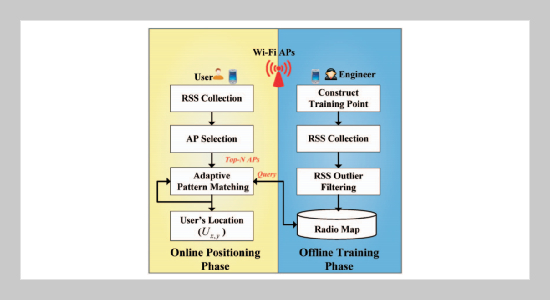Chi-Fu Hung 1, Chiu-Ching Tuan1 and Fong-Mao Jhuang1
1Department of Electronic Engineering, National Taipei University of Technology, Taipei, Taiwan 106, R.O.C.
Received:
November 27, 2015
Accepted:
July 10, 2016
Publication Date:
September 1, 2016
Download Citation:
||https://doi.org/10.6180/jase.2016.19.3.12
ABSTRACT
This study proposes a method based on access point (AP) selection and adaptive pattern-matching for Wi-Fi indoor positioning (ASAPM). In the proposed ASAPM, a box plot algorithm is used to remove received signal strength (RSS) outliers in samples received from APs in order to smooth the RSS. Subsequently, we analyzed the RSS variations for selecting the top-N APs with the least interference. Moreover, we analyzed the history of the positioning results to estimate the direction and distance of users in subsequent positions in order to reduce the pattern-matching time and computational overhead of the positioning system. The simulation results revealed that the average positioning error, average maximum positioning error, and average pattern-matching times of ASAPM were 36%, 51%, and 57% lower than the three compared strategies, respectively. These findings show that ASAPM could reduce the computational overhead; moreover, it is suitable as an indoor-positioning service for mobile devices.
Keywords:
Access Point Selection, Adaptive Pattern-matching, Indoor Positioning, Received Signal Strength, Box Plot
REFERENCES
- [1] Zhu, L., Yang, A., Wu, D. and Liu, L., “Survey of Indoor Positioning Technologies and Systems,” Life System Modeling and Simulation, Vol. 461, pp. 400 409 (2014). doi: 10.1007/978-3-662-45283-7_41
- [2] Prithiviraj, V., Krishnaveni, B. V. and Jayabharathy, R., “Evaluating Context Based Indoor Positioning System Using Wi-Fi Standards,” Proc. of International Conference on Communications and Signal Processing, India, Apr. 35, pp. 982987 (2013). doi: 10. 1109/iccsp.2013.6577203
- [3] Pritt, N., “Indoor Location with Wi-Fi Fingerprinting,” Proc. of IEEE Applied Imagery Pattern Recognition Workshop: Sensing for Control and Augmentation, Washington, Oct. 2325, pp. 18 (2013). doi: 10. 1109/AIPR.2013.6749334
- [4] Hossain, A. K. M. M. and Soh, W. S., “A Survey of Calibration-free Indoor Positioning Systems,” Computer Communications, Vol. 66, pp. 113 (2015). doi: 10.1016/j.comcom.2015. 03.001
- [5] Gu, Y., Lo, A. and Niemegeers, I., “A Survey of Indoor Positioning Systems for Wireless Personal Networks,” IEEE Communications Surveys & Tutorials, Vol. 11, No. 1, pp. 1332 (2009). doi: 10.1109/SURV.2009.09 0103
- [6] Boonsriwai, S. and Apavatjrut, A., “Indoor Wi-Fi Localization on Mobile Devices,” Proc. of International Conference on Electrical Engineering/Electronics, Computer, Telecommunications and Information Technology (ECTI-CON), Gwangju, May. 1517, pp. 15 (2013). doi: 10.1109/ECTICon.2013.6559592
- [7] Kim, J., Ji, M., Cho, Y., Lee, Y. and Park, S., “Fingerprint DB Generating System Exploiting PDR Based Dynamic Collection for Indoor Localization of Smartphone Users,” Proc. of 13th International Conference on Control, Automation and Systems (ICCAS), Oct. 2023, pp. 715718 (2013). doi: 10.1109/ICCAS.2013. 6703964
- [8] Ankur, A., Parakram, K. and Huzur, S, “LOCATOR: Location Estimation System for Wireless LANs,” Proc. of Wireless Mobile Applications and Services on WLAN Hotspots, U. S. A., Sep. 26Oct. 1, pp. 102 109 (2004).
- [9] Lin, T. N., Fang, S. H., Tseng, W. H., Lee, C. W. and Hsieh, J. W., “A Group-discrimination-based Access Point Selection for WLAN Fingerprinting Localization,” IEEE Transactions on Vehicular Technology, Vol. 63, No. 8, pp. 39673976 (2014). doi: 10.1109/ TVT.2014.2303141
- [10] Lee, C. W., Lin, T. N., Fang, S. H. and Chou, Y. C., “A Novel Clustering-based Approach of Indoor Location Fingerprinting,” Proc. of IEEE 24th International Symposium on Personal Indoor and Mobile Radio Communications (PIMRC), London, Sep. 811, pp. 3191 3196 (2013). doi: 10.1109/PIMRC.2013.6666696
- [11] Fang, S. H. and Lin, T. N., “Accurate WLAN Indoor Localization Based on RSS Fluctuations Modeling,” Proc. of IEEE International Symposium on Intelligent Signal Processing, Budapest, Aug. 2628, pp. 2730 (2009). doi: 10.1109/WISP.2009.5286581
- [12] Zhou, Y., Chen, X. and Zeng, S., “AP Selection Algorithm in WLAN Indoor Localization,” Information Technology Journal, Vol. 12, No. 16, pp. 37733776 (2013). doi: 10.3923/itj.2013.3773.3776
- [13] Miao, H., Wang, Z., Wang, J., Zhang, L. and Liu, Z., “A Novel Access Point Selection Strategy for Indoor Location with Wi-Fi,” Proc. of the 26th Chinese Control and Decision Conference (2014 CCDC), Changsha, China, May. 31Jun. 2, pp. 52605265 (2014). doi: 10.1109/CC DC.2014.6853119
- [14] Nuaimi, K. A. and Kamel, H., “A Survey of Indoor Positioning Systems and Algorithms,” Proc. of International Conference on Innovations in Information Technology (IIT), Abu Dhabi, Apr. 2527, pp. 185190 (2011). doi: 10.1109/INNOVATIONS.2011.5893813
- [15] Atia, M. M., Noureldin, A. and Korenberg, M. J., “Dynamic Online-calibrated Radio Maps for Indoor Positioning in Wireless Local Area Networks,” IEEE Transactions on Mobile Computing, Vol. 12, No. 9, pp. 17741787 (2013). doi: 10.1109/TMC.2012.143
- [16] Bahl, P. and Padmanabhan, V. N., “RADAR: an In-building RF-based User Location and Tracking System,” Proc. of IEEE INFOCOM 2000, Tel Aviv, Mar. 2630, pp. 775784 (2000). doi: 10.1109/INF COM.2000.832 252
- [17] Bahl, P., Padmanabhan, V. N. and Balachandran, A., “Enhancements to the RADAR User Location and Tracking System,” Microsoft Research, Report No. MSR-TR-2000-12, Redmond, WA, U.S.A. (2000).
- [18] Gansemer, S., Grossmann, U. and Hakobyan, S., “RSSI-based Euclidean Distance Algorithm for Indoor Positioning Adapted for the Use in Dynamically Changing WLAN Environments and Multi-level Buildings,” Proc. of International Conference on Indoor Positioning and Indoor Navigation (IPIN), Zurich, Sep. 1517, pp. 16 (2010). doi: 10.1109/IPIN.2010.5648 247
- [19] Youssef, M. A., Agrawala, A. and Shankar, A. U., “WLAN Location Determination via Clustering and Probability Distributions,” Proc. of International Conference on Pervasive Computing and Communications, Fort Worth, Mar. 26, pp. 143150 (2003). doi: 10. 1109/PER COM.2003.1192736
- [20] Ma, L., Ma, X., Liu, X. and Xu, Y., “WLAN Indoor Positioning Algorithm Based on Sub-regions Information Gain Theory,” Proc. of IEEE Wireless Communications and Networking Conference (WCNC), Shanghai, China, Apr. 710, pp. 47894794 (2013). doi: 10.1109/ WCNC.2013.6555351
- [21] Bergamasco, M., Rossa, F. D. and Piroddi, L., “Active Noise Control of Impulsive Noise with Selective Outlier Elimination,” Proc. of American Control Conference (ACC), Washington, Jun. 1719, pp. 41654170 (2013). doi: 10.1109/ACC.2013.6580479
- [22] Li, B., Salter, J., Dempster, A. G. and Rizos, C., “Indoor Positioning Techniques Based on Wireless LAN,” Proc. of IEEE International Conference on Wireless Broadband and Ultra Wideband Communications, Australia, Mar. 1316, Paper 113 (2006).
















